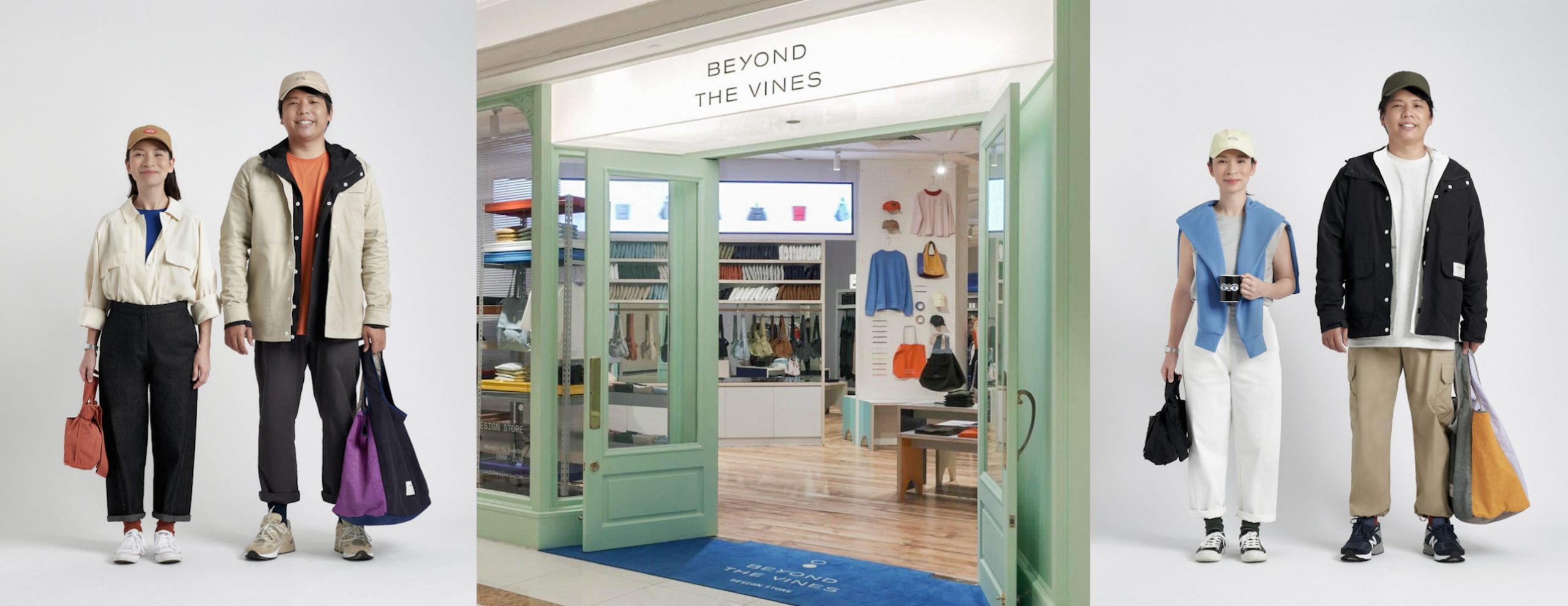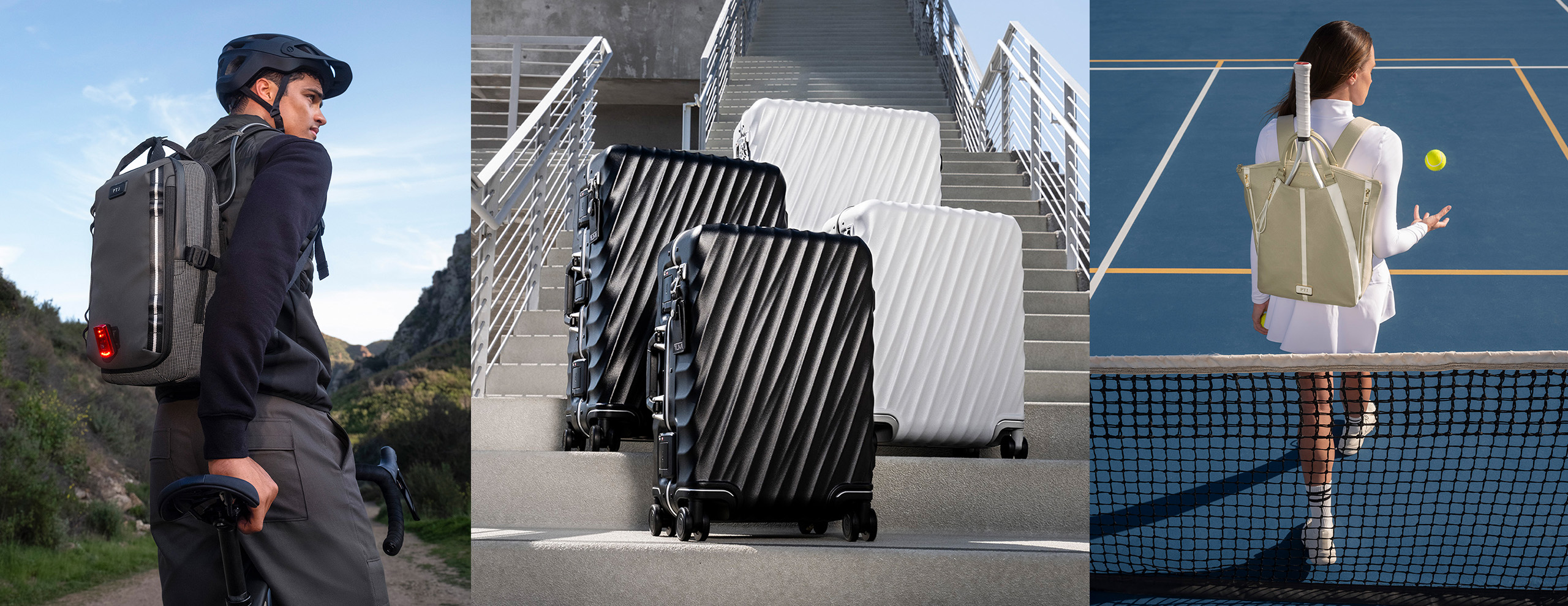I was scrolling through social media one fine Tuesday when I chanced upon a farewell post on the Beyond The Vines page, accompanied by a heartfelt letter, penned by brand founder Rebecca Ting. Tags, postcards, and a tote bag were placed in a box, sealed up, and marked with a date like we do our precious childhood treasures. Alarmed, I thought — was this the end of one of my favourite homegrown brands? Well, I was wrong. Gladly. Instead, it marked a new beginning; and you know what they say about closed doors and open windows.
The light now shines on a refreshed Beyond The Vines, one that still embraces their ethos of minimalist wear, but with a new brand identity more akin to a design studio, as mint double doors beckon us to enter their latest Design Store in the heart of Orchard.

Husband-and-wife duo, Rebecca Ting and Daniel Chew believe that while the brand will continue to create “well-designed products made accessible to all”, it needed to be true to them and their growth over the last five years. “It is absolutely necessary that we intentionally disrupted ourselves”, the letter boldly reflects. So what’s new here? For that, we had to have a chat with the founders themselves.

Almost instinctively, both of them felt they needed to “peel the layers off” of what fashion should look like. “We design to that extent, the rest would be interpreted by the wearer,” says Daniel. Minimalism isn’t just about clean lines or a certain aesthetic — that’s what I got the sense of as Rebecca talks about the brand’s design process. It’s about intentionality, the edit, making sure that every single detail is necessary and serves a purpose.
An extra pleat on a cargo pant pocket not only looks good, it serves as an extra fold where you can store a small item; an angular pocket mimics the pleats; a grosgrain label at the back of a shirt adds a subtle embellishment that distinguishes the brand. You get the idea, minute touches here are, essentially, hidden in plain sight — incidentally, the name of the brand’s debut collection.
above: the latest design store.
Along with that, they’re also debuting a new menswear line to go along with their ready-to-wear core collection, as well as some fun and functional lifestyle items that include pencils, key rings, and… a camp stool! Read on for more insight into the brand’s stunning evolution.
Why did you and Daniel decide on the rebrand? Would you say that your design philosophy remains the same?
Rebecca: “The core’s still the same — why we design, why we do. It’s about well-designed products at accessible price points. We believe that the core of design is about being able to solve a problem. And while that hasn’t changed, after 5 years, we felt a change was necessary.
What we were using the voice of the brand for mattered to us, we needed to use that voice for something. We wanted to use real people with real voices and impact on society to front the brand, because we felt that was who we are — Dan and I are very inclusive people, we’re very warm and we like to have a good time, so that was the heartbeat of it: keeping the core of our design ethos but peeling the layers off what fashion should look like.
Can you elaborate more on what “peeling the layers off” means?
R: “The products we design don’t suit just one kind of customer — we design to a certain extent, and we allow the customer to take a journey of their own. For example, the Dumpling Bags, when people take it home, it fits into their style, it doesn’t define their style.”
Daniel: “One of the objectives we wanted to achieve was to eliminate the limitations of age — it’s not about an age in life, what we’re trying to reach is the way of life. You can be a 50-year-old or a 17-year-old, you’re still carrying the same Dumpling Bag. We design to that extent, the rest would be interpreted by the wearer. We’re beckoning people to come on a journey with us and interpret it however they like.”


How do the timeless designs align with the Design Studio concept?
R: “The garments are modular. If you look at them in terms of like, these tops, you can wear it with trousers or a skirt, they’re very basic-looking. Same with design, we design to a certain point, but when someone wears it, their style doesn’t get cramped by the one look. We prefer it that way, we feel that design creates room for the user. Although we started with Ready-To-Wear, we do feel that the core of our design values have always been that of a Design Studio, so this rebranding opened it up for us.”
In a “farewell” letter that reflects on Beyond The Vines’ evolution, there was the idea of disrupting yourselves. What can we understand from that?
R: “This wasn’t sudden — we planned this maybe more than a year ago. We felt like we need to disrupt ourselves. Comfort is great, but at the same time, it means you’re not really growing, and even internally we encourage the team to always be ready for change. For us, when the brand was about to turn 5, we instinctively felt like we needed to change, to give the brand a new voice, a new soul. It needed to be refreshed. I felt it needed to represent even truer versions of ourselves. When people come to the store, it’s like, I know this music. That there’s a soul to the brand, that was important to us, that people feel that connection and kindred spirit.”
Has the new perspective brought new insight to the way you design?
R: “If anything, we’re more aware of our design strength — to balance form and function, not too utilitarian that there’s no aesthetic, but at the same time, not fully aesthetic that it can’t be used. This approach has been through our designs, whether that’s the Reversible Bags, Dumpling Bags, our dresses always have pockets, same for our trousers. The bags are adjustable, water-resistant, packable, yet it doesn’t look like a utility bag. That came forth stronger for us and that’s where our strength is. This rebranding has brought about more clarity; we’re reminded not be afraid to put that out and be the truer versions of ourselves.”
ABOVE: the ‘in plain sight’ collection.
There’s now a whole new menswear line! How would you describe it?
R: “I think it’s a mirror reflection of the brand. Even our new brand mark sees this — we dropped the pink and the stitch logo, which evolved into a logo of two overlapping circles, one void, the other solid. It’s a play on duality: form / function, menswear / womenswear. The philosophy of our design is always about tension, the day and the night, sowing and reaping, the order of things that are made.
For menswear, we designed the pieces to be functional. Take these trousers, the pockets are this way but also this other way, and then there’s a toggle at the bottom, while these snap buttons are all made in Japan. Externally, they look “like this”, but every part is intentional.”
What does ‘minimalism’ mean to you?
R: “We feel like it takes more to design something simple than to design something that’s complex, frankly speaking, because you remove, remove, remove until you only leave what is necessary behind. Does this need to be there? What is it doing to it? It’s about the edit, absolutely. If it doesn’t need to be there, it should not be there for the sake of it, and yet at the same time, if it is there, where can we position it best?”
What are some of your proudest designs so far?
R: “We have a good team, and one of the proudest moments for the design team has to be this new identity. I felt like we did well with the menswear, frankly speaking. It was a long time in the process, we started designing this last year, and we went through rounds of sampling and colour — the team even wore the pieces, washed them, to see if they stand up to the test. Men might feel like there’s a gap in finding design-centric garments that are functional and accessible, so I feel like we did well with this one.”


On to the very well-loved Dumpling Bags — tell us more about the design process, and why you think they’re so popular.
R: “When we made it, we wanted to have as little hardware as possible, because hardware’s very “trendy”, and we don’t see ourselves as a trendy brand. We feel like we’re more a lifestyle, way-of-life brand. We want people to take the bag on multiple journeys, rather than have one bag for certain occasions. We also needed it to be light, packable, water-resistant.
We had those key points, and we started to eliminate throughout the process. The only hardware was what needed to be there — the keyring, and the adjustable strap, in matte. The classic — navy, white, black, olive — are monochrome, but we contrasted the seasonal ones with some detailing for that little spunk. We were also thinking about the way the bag closed. Do we want to put something there?
The whole process of the bag was very user-centric, which, I think, is one of the reasons why people loved it. There are people who own it in multiple colours, like 6 colours, you know! It’s quite intense. When we did a livestream on Instagram, they saw how many things we could pack in the bag — a bottle, an iPad, wallet, food, mask, makeup, random things, and it didn’t even look full. What we noticed was that customers bought one, and then started buying a few more colours, which started that whole wave.”
above: ‘A world beyond’, which debuts some lifestyle items — to be launched soon.
Shop at beyondthevines.com and the Design Store at #B1-42/46
Takashimaya Shopping Centre, Ngee Ann City.











You must be logged in to post a comment.